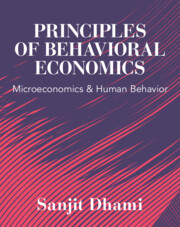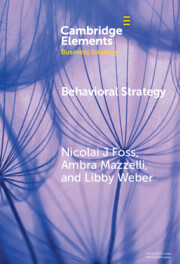Refine search
Actions for selected content:
91 results
Nudging and boosting reasonable use of public products: two experiments from China
-
- Journal:
- Behavioural Public Policy , First View
- Published online by Cambridge University Press:
- 24 November 2025, pp. 1-25
-
- Article
-
- You have access
- Open access
- HTML
- Export citation
9 - Psychology + Economics = Behavioral Economics = Ways to (Gently) Influence Decisions
- from Introduction to Part II: Cognitive Processes of Decision Making
-
- Book:
- Making Decisions: Analytics, Cognition, and Application
- Published online:
- 23 October 2025
- Print publication:
- 06 November 2025, pp 110-124
-
- Chapter
- Export citation
A Quantitative Analysis of Rational Decisions Under Uncertainty in Engineering Systems Design
-
- Journal:
- Proceedings of the Design Society / Volume 5 / August 2025
- Published online by Cambridge University Press:
- 27 August 2025, pp. 249-258
-
- Article
-
- You have access
- Open access
- HTML
- Export citation
Analytical insights on a behavioral macroeconomic model
-
- Journal:
- Macroeconomic Dynamics / Volume 29 / 2025
- Published online by Cambridge University Press:
- 26 August 2025, e135
-
- Article
-
- You have access
- Open access
- HTML
- Export citation
Moving from nudging to boosting: empowering behaviour change to address global challenges
-
- Journal:
- Behavioural Public Policy / Volume 9 / Issue 4 / October 2025
- Published online by Cambridge University Press:
- 15 April 2025, pp. 874-885
-
- Article
-
- You have access
- Open access
- HTML
- Export citation
Motivated reasoning about artificial intelligence in public policy: comparative evidence from Germany
-
- Journal:
- Behavioural Public Policy , First View
- Published online by Cambridge University Press:
- 27 March 2025, pp. 1-21
-
- Article
-
- You have access
- Open access
- HTML
- Export citation
Saving behavior and cognitive abilities
-
- Journal:
- Experimental Economics / Volume 14 / Issue 3 / September 2011
- Published online by Cambridge University Press:
- 14 March 2025, pp. 349-374
-
- Article
- Export citation
Does level-k behavior imply level-k thinking?
-
- Journal:
- Experimental Economics / Volume 24 / Issue 1 / March 2021
- Published online by Cambridge University Press:
- 14 March 2025, pp. 330-353
-
- Article
- Export citation
Confusopoly: competition and obfuscation in markets
-
- Journal:
- Experimental Economics / Volume 19 / Issue 2 / June 2016
- Published online by Cambridge University Press:
- 14 March 2025, pp. 299-316
-
- Article
- Export citation
Bargaining and Dilemma Games: From Laboratory Data Towards Theoretical Synthesis
-
- Journal:
- Experimental Economics / Volume 1 / Issue 3 / December 1998
- Published online by Cambridge University Press:
- 14 March 2025, pp. 257-281
-
- Article
- Export citation
The relevance of irrelevant information
-
- Journal:
- Experimental Economics / Volume 24 / Issue 3 / September 2021
- Published online by Cambridge University Press:
- 14 March 2025, pp. 985-1018
-
- Article
- Export citation
The effect of payoff tables on experimental oligopoly behavior
-
- Journal:
- Experimental Economics / Volume 15 / Issue 3 / September 2012
- Published online by Cambridge University Press:
- 14 March 2025, pp. 499-509
-
- Article
- Export citation
An eye-tracking study of feature-based choice in one-shot games
-
- Journal:
- Experimental Economics / Volume 19 / Issue 1 / March 2016
- Published online by Cambridge University Press:
- 14 March 2025, pp. 177-201
-
- Article
- Export citation
Does seeing more deeply into a game increase one's chances of winning?
-
- Journal:
- Experimental Economics / Volume 9 / Issue 3 / September 2006
- Published online by Cambridge University Press:
- 14 March 2025, pp. 297-303
-
- Article
- Export citation

Principles of Behavioral Economics
- Microeconomics and Human Behavior
-
- Published online:
- 13 February 2025
- Print publication:
- 16 January 2025
-
- Textbook
- Export citation
Does exposure to alternative decision rules change gaze patterns and behavioral strategies in games?
-
- Journal:
- Journal of the Economic Science Association / Volume 5 / Issue 1 / August 2019
- Published online by Cambridge University Press:
- 17 January 2025, pp. 14-25
-
- Article
-
- You have access
- Open access
- HTML
- Export citation
5 - Economics of Energy Efficiency
-
- Book:
- An Introduction to Energy Economics and Policy
- Published online:
- 19 December 2024
- Print publication:
- 19 December 2024, pp 102-126
-
- Chapter
-
- You have access
- Open access
- Export citation
6 - Reconceptualizing Organizational Control
- from Part III - Quo Vadis Organizational Control?
-
- Book:
- Reconceptualizing Organizational Control
- Published online:
- 21 November 2024
- Print publication:
- 28 November 2024, pp 161-256
-
- Chapter
- Export citation
4 - The Economic Efficiency of Policies to Reduce Ill Health Involving Environmental Factors
-
-
- Book:
- The Cambridge Handbook of Healthcare
- Published online:
- 21 November 2024
- Print publication:
- 28 November 2024, pp 110-135
-
- Chapter
- Export citation

Behavioral Strategy
- Exploring Microfoundations of Competitive Advantage
-
- Published online:
- 26 November 2024
- Print publication:
- 19 December 2024
-
- Element
- Export citation
